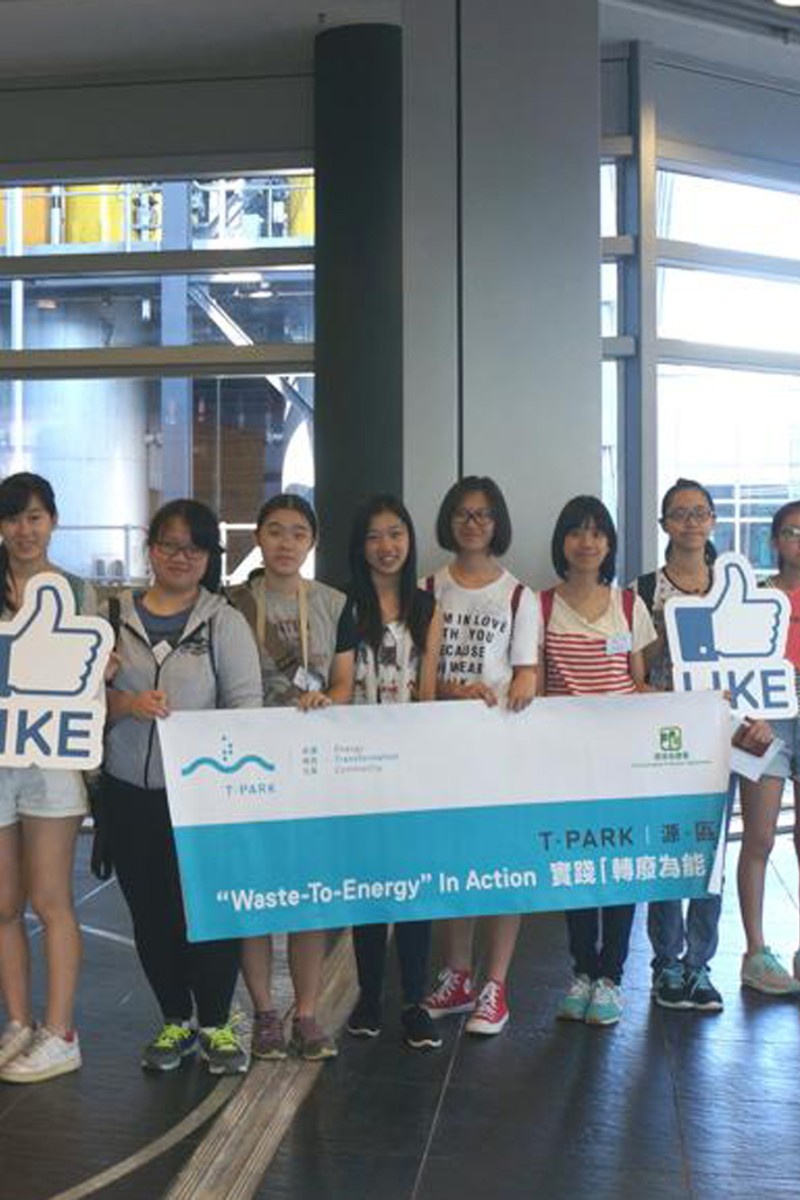
Would you go to a pool and spa that uses sludge - sewage from toilets and kitchens - if it means helping the environment?
Hong Kong produces approximately 1,200 tonnes of sludge every day, which is dumped into three designated landfills. But is there another way in which we can deal with the waste?
 The JRs give two huge thumbs up for what T-Park is doing for the environment.
The JRs give two huge thumbs up for what T-Park is doing for the environment.Sludge is sewage from the toilet and waste from cooking and cleaning. No one likes sludge. It’s smelly and gross – but at T-Park, a waste treatment facility in Tuen Mun, sludge is being converted into energy for use in everyday life.
Junior reporters Henry Lui, Jeanie Li, Nicholas Ng and Eunice Yip spent a day at the site to find out how the process happens – and to check out the amazing facilities and attractions that are also available there.
The science behind T-Park
Fresh water is generated on-site at the facility which is on the edge of Tuen Mun along the coast of Deep Bay. Seawater is sucked into the building and goes through what is known as a desalination process. The process involves removing impurities in the water through a three-step screening, settlement, and filtration procedure, and the final product is free of unpleasant things like fish poo.
The water then goes through reverse osmosis, which is when particles move from an area of high concentration to an area of lower concentration. This completely removes salt and dirt from the liquid, which means the water can be freely used in and around the facility.
The plant’s main function is to cut down on the quantity of sludge waste that is disposed of in landfills (which it does by burning thick sludge until only ash and residues are left), but the facility also produces electricity. As the sludge is incinerated, it can reach temperatures of up to 850 degrees Celsius, which generates enough heat to boil the water in the pipes in the surrounding walls and turns into steam. This steam is then diverted through a turbine, which converts the kinetic energy into electricity. The electricity that is generated is enough to cover all of T-Park’s operational needs – plus 4,000 households nearby.
Henry Lui
T is for Transformation
Designed by well-known French architect Claude Vasconi, the sludge treatment facility has been built to be as environmentally friendly as possible. It uses sunlight, natural ventilation and green roofs to minimise energy consumption.
The machines at the facility are helping to change the environment of Hong Kong for the better as they help decrease the amount of sludge that needs disposing by up to 90 per cent. This reduces the amount that goes to landfills and makes Hong Kong a greener city. However, Michelle Au Wing-tsz, a political assistant from the Environment Bureau, said that Hongkongers must also play their part in creating a sustainable future for the city.
Jeanie Li
So much to see at T-Gallery
The Hall is an exhibition that illustrates the sludge treatment process. It also hosts a variety of models, simulations, interactive games and real-life footage from the plant itself. The Hall’s minimalist design really reflects the plant’s theme of being simple, yet self-sufficient.
T-Gallery illustrates the “waste-to-energy” process through life-size models and interactive displays. We learned about the main system that monitors the entire facility, called Scada, through videos. Giant windows let us look right into the machinery, technology and the designs that made the process work. When the guide informed us that we were standing less than four metres away from one of the major incinerators in the station, we junior reporters got more than a little nervous.
T-Park shouldn’t be discounted as just a sludge treatment and water purification plant. The facility demonstrates how self-sufficiency, education and leisure activities can go hand-in-hand with respect for the environment.
In fact, I guess you could say the time and money that has been invested in this project definitely hasn’t been a “waste” of time.
Nicholas Ng
Take a dip in sludge-free pools
The self-sustained factory generates fresh water on-site through a seawater desalination plant, and rainwater is collected for use. All the sewage from the facility is treated and reused for irrigation, flushing and cleaning purposes.
One of T-Park’s more well-known amenities is T-Spa. Yes, a spa.
The three spa pools, each 0.9m deep and uniquely shaped, have different water temperatures, as a result of using the heat energy produced by the sludge treatment process. There is a hot pool of 40 degrees C, a warm 25 degrees pool and a 15 degrees cold pool. Visitors are allowed to dip in and out of the pools as they like.
The spa has floor-to-ceiling windows so visitors can enjoy the beautiful sea view and the surrounding greenery as they relax in the water. Who would have thought that a thing like a spa in a sludge treatment facility would work? T-Spa is open for four sessions a day. Each session is 90 minutes long, and can accommodate around 50 people. Most importantly, it is free of charge (yes, you read that right), and can be booked through T-Park’s website.
Eunice Yip